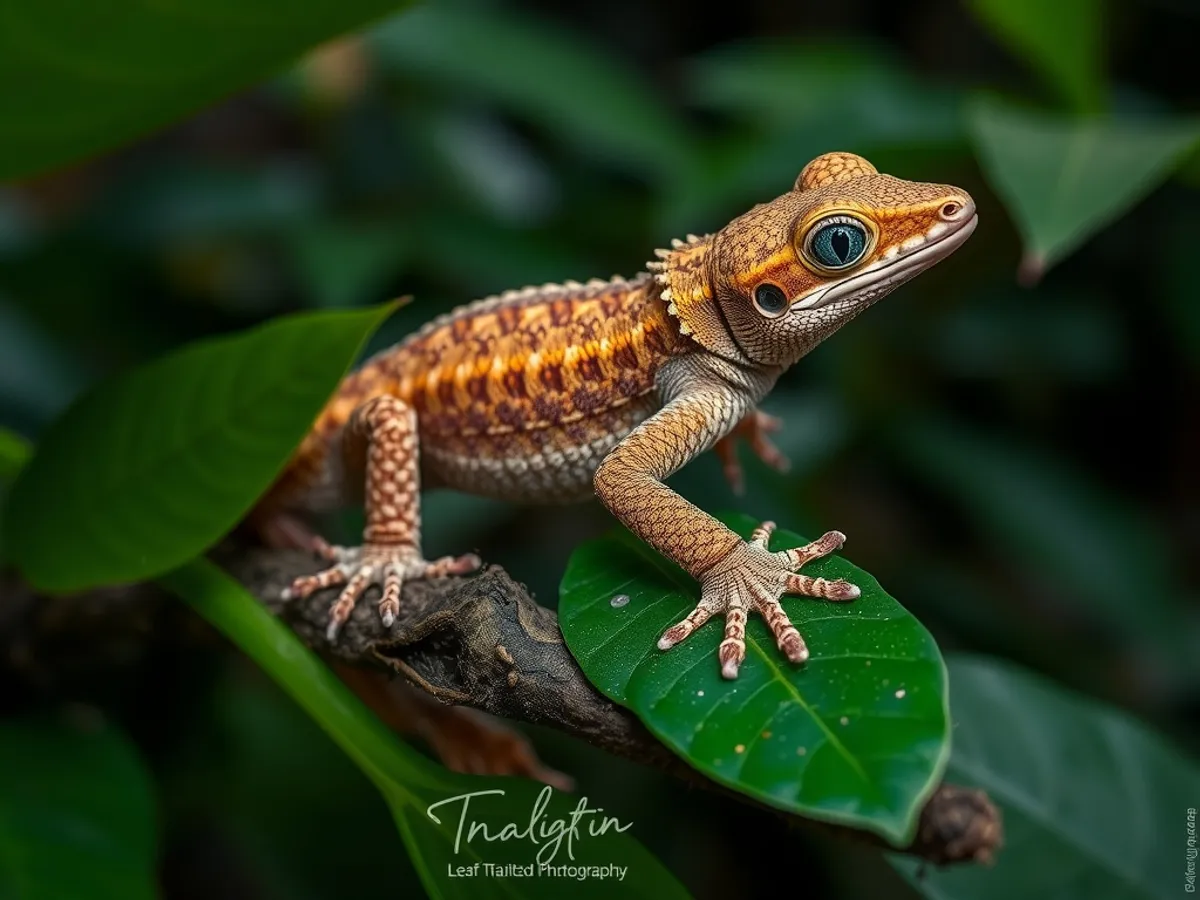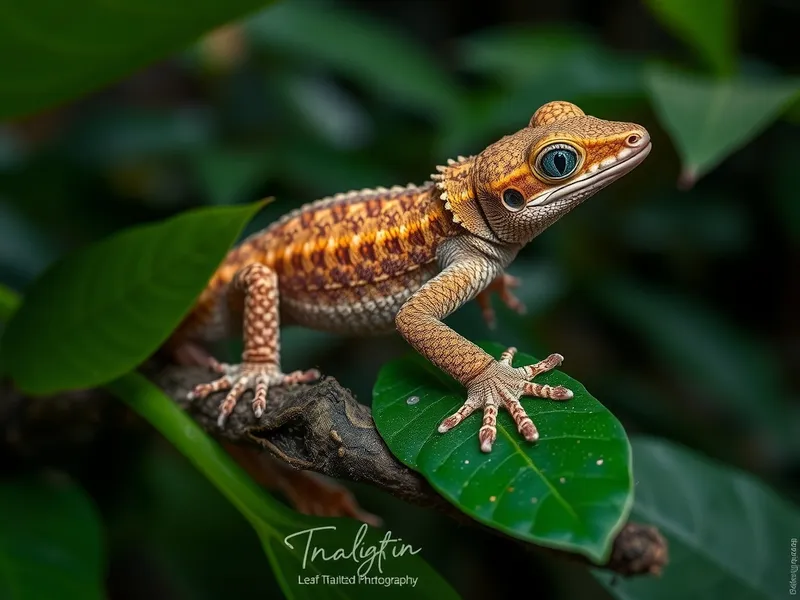
Uroplatus leaf-tailed gecko
Uroplatus fimbriatus

Meet the Uroplatus leaf-tailed gecko
The Uroplatus leaf-tailed gecko is a remarkable reptile known for its extraordinary camouflage, perfectly mimicking dead leaves and tree bark. Native to the rainforests of Madagascar, this nocturnal gecko has a broad, flat tail edged with fringed skin flaps that help break up its outline. Its mottled brown, gray, and green coloration further aids in blending with its surroundings, providing protection from predators. The species is arboreal, spending most of its life clinging to tree trunks and branches in dense forest environments.
Classification
Reptile
Habitat
Tropical rainforest
Diet
Carnivore
Lifespan
5-10 years
Conservation
Vulnerable
Weight
10-30 grams
📖Fascinating Facts
Masters of Disguise
Their fringed skin and leaf-shaped tails help them blend seamlessly with dead leaves and tree bark, making them nearly invisible to both prey and predators.
Nocturnal Hunters
Uroplatus leaf-tailed geckos are strictly nocturnal, emerging at night to hunt insects and other small invertebrates.
Unique Tail Defense
If threatened, these geckos can shed their tails as a distraction, allowing them to escape from predators. The tail does not regrow to its original form.
📋Detailed Description
Uroplatus fimbriatus, commonly known as the giant leaf-tailed gecko, is the largest member of its genus, reaching total lengths of up to 33 cm (13 in), with females generally larger than males. Its body is dorsoventrally flattened, and the tail is broad, leaf-shaped, and fringed with dermal flaps that extend along the limbs and body, enhancing its camouflage by disrupting its outline against tree bark and leaves. The skin exhibits a complex pattern of mottled browns, grays, and greens, which can be subtly altered through chromatophores to match the surrounding substrate. The gecko possesses large lidless eyes with vertical pupils, optimized for nocturnal vision, and a specialized toe structure with adhesive lamellae, allowing for secure climbing on smooth and vertical surfaces. Uroplatus fimbriatus is strictly arboreal, rarely descending to the forest floor, and is most active during the humid nights of Madagascar’s eastern rainforests. Its cryptic appearance is complemented by a behavior of remaining motionless and flattened against tree trunks during the day to avoid detection by predators. The species is solitary and highly territorial, with individuals occupying defined home ranges. When threatened, it may open its mouth to display a bright red interior as a deimatic display. Its diet consists primarily of large arthropods, but it may occasionally consume smaller vertebrates. The gecko's reproductive strategy involves laying small clutches of eggs in concealed locations, with minimal parental care post-oviposition. This species plays a significant ecological role as both predator and prey within its rainforest ecosystem.
💡 Did you know?
Despite their impressive camouflage, Uroplatus leaf-tailed geckos are sometimes detected by predators due to their reflective eyes, which can shine in torchlight at night.
🔬Research & Sources
🎭Behavior & Social Structure
Uroplatus fimbriatus is a nocturnal ambush predator, emerging at dusk to hunt insects such as moths, crickets, beetles, and occasionally small vertebrates like frogs. It relies on stealth and camouflage, remaining motionless for long periods before lunging at prey with a rapid strike. The gecko uses its acute vision to detect movement in low light. Social interactions are limited, as individuals are solitary except during the breeding season. Territorial disputes are resolved through visual displays and, rarely, physical confrontation. During the day, the gecko adopts a flattened posture against tree trunks, aligning its body and tail to maximize camouflage. It is generally sedentary, moving only short distances within its home range, and is highly sensitive to disturbances, quickly retreating to cover if threatened.
👶Reproduction & Life Cycle
Breeding occurs primarily during the rainy season (November to March), when increased humidity facilitates egg development. Males court females through tactile and visual signals, including tail waving and body posturing. After mating, females lay 2–4 elliptical, parchment-shelled eggs in concealed locations such as under loose bark or leaf litter. The incubation period ranges from 60 to 90 days, depending on temperature and humidity. There is no parental care after egg deposition; hatchlings are fully independent and exhibit cryptic coloration from birth. Sexual maturity is typically reached at 18–24 months. Clutch frequency is influenced by environmental conditions, with some females producing multiple clutches per season.
🛡️Adaptations & Survival
Uroplatus fimbriatus exhibits several remarkable adaptations for arboreal and nocturnal life. Its dermal flaps and fringed tail break up its outline, providing exceptional camouflage against predators such as birds and snakes. The gecko’s skin contains chromatophores, enabling subtle color changes to match its environment. Its large eyes, lacking eyelids but protected by a transparent spectacle, provide excellent night vision, while the tongue is used to clean the spectacle. Specialized toe pads with microscopic setae generate van der Waals forces, allowing adhesion to smooth and vertical surfaces. The flattened body and tail facilitate close contact with substrates, enhancing concealment. Behavioral adaptations include motionless daytime resting and rapid escape responses.
📚Research Sources
🎨Cultural Significance
While Uroplatus fimbriatus does not have a prominent role in Malagasy folklore compared to other endemic species, its extraordinary appearance has made it a symbol of Madagascar’s unique biodiversity. It is sometimes featured in ecotourism and conservation awareness campaigns, highlighting the importance of rainforest preservation. In the international pet trade, it is prized for its rarity and camouflage, which has unfortunately contributed to illegal collection. There are no known traditional medicinal or utilitarian uses among local communities.
🔬Recent Research & Discoveries
Recent research has focused on the biomechanics of the gecko’s adhesive toe pads and the microstructure of its skin, revealing insights into biomimetic applications for synthetic adhesives. Genetic studies have clarified the phylogenetic relationships within the Uroplatus genus, aiding in conservation prioritization. Ongoing field studies are assessing population densities, habitat preferences, and the impact of habitat fragmentation. Notably, a 2021 study used environmental DNA (eDNA) to detect Uroplatus fimbriatus presence in degraded habitats, offering new tools for monitoring elusive populations. Conservation genetics is also being applied to evaluate genetic diversity and inform captive breeding programs.
🎥Wildlife Videos

LEAF-TAILED GECKOS (UROPLATUS) IN THE WILD! (Are we keeping them correctly?)
Of all the reptiles and amphibians of Madagascar, one particular gecko stands out in the crowd, the leaf-tailed geckos of the genus ...
Dāv Kaufman's Reptile Adventures

Leaf-Tailed Geckos: Animals That Disappear in the Wild | Discover HD
Leaf-Tailed Geckos: Animals That Disappear in the Wild | Discover HD Description: Meet the Leaf-Tailed Gecko, one of nature's ...
Descover HD

SATANIC LEAF-TAILED GECKOS IN THE WILD! (Are we keeping them correctly)
Satanic Leaf-tailed Geckos (Uroplatus phantasticus) are some of the most rewarding lizards reptile keepers can work with, and on ...
Dāv Kaufman's Reptile Adventures

Leaf-Tailed Gecko | Uroplatus phantasticus | Satanic Leaf Tail Gecko | Mossy Leaf-Tail Gecko
The leaf-tailed gecko, a lengthy lizard, has quite a unique physique. With a broad and triangular head, their name comes from the ...
SITHEEQUE

These Aussie Geckos Are Truly 🤯!
The Northern Leaf Tailed Gecko ( Saltuarius cornutus ) and the Chameleon Gecko ( Carphodactylus laevis ) featured in this video ...
Made in the Wild

Satanic Leaf Tailed Gecko Nature's Leafy Animal
Welcome to our educational channel! At FGH World 24 Education, we are dedicated to providing you with engaging and ...
FGH World 24
🌍Habitat Information
The Uroplatus leaf-tailed gecko typically inhabits Tropical rainforest environments. Uroplatus leaf-tailed geckos have adapted to their environments with specialized features and behaviors.
Primary Habitat:
Tropical rainforest
More detailed habitat information will be available soon.
🛡️Conservation Status
The Uroplatus leaf-tailed gecko is currently classified as Vulnerable. Conservation efforts are crucial for preserving this species for future generations.
Common Threats:
- 🏠Habitat loss and fragmentation
- 🌡️Climate change impacts
- 🎯Hunting and poaching
- 🏭Human-wildlife conflict
⚠️Threats & Conservation Challenges
The primary threats to Uroplatus fimbriatus are habitat loss due to deforestation, slash-and-burn agriculture, and illegal logging in Madagascar’s eastern rainforests. The species is also targeted by the international pet trade, despite regulations. Population fragmentation and declining habitat quality have led to its classification as Vulnerable by the IUCN. Climate change poses additional risks by altering habitat conditions and affecting prey availability. Conservation challenges include limited enforcement of protective legislation, insufficient habitat corridors, and lack of comprehensive population data. Community-based conservation and habitat restoration are critical for the species’ survival.
🔬Scientific Classification
Scientific Name
Uroplatus fimbriatus
Classification Hierarchy
🔍 About Taxonomic Classification
Taxonomic classification is a hierarchical system used by scientists to classify and organize living organisms based on shared characteristics and evolutionary relationships.
The system moves from broad categories (Kingdom) to increasingly specific ones, with each animal's scientific name typically consisting of its Genus and species.
📝Community Notes
Share your observations and insights about the Uroplatus leaf-tailed gecko with our community of wildlife enthusiasts.
Join Our Community
Sign in to share your observations and connect with fellow wildlife enthusiasts.
Sign In to ContributeNo community notes yet
Be the first to share your observations about the Uroplatus leaf-tailed gecko!
Explore Uroplatus leaf-tailed gecko
Select a tab above to learn more about this amazing animal.
📸Photo Gallery
No photos available for this animal yet.
🌟Discover More Wildlife
Continue your journey of discovery with more fascinating animals from our database
